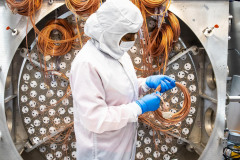The LZ Collaboration at our bi-annual meeting at Brown University, June 2024.
The LZ Collaboration at our bi-annual meeting at the University of Edinburgh, January 2024.
 LZ holds Collaboration Meeting at Rutherford Appleton Laboratory near Oxford on 6-8 January
LZ holds Collaboration Meeting at Rutherford Appleton Laboratory near Oxford on 6-8 January

Lowering LZ Time Projection Chamber Into Inner Cryostat Vessel – Video

LZ underside of bottom PMT Array – Video
 Kimberly Palladino, an assistant professor of physics at UW–Madison, works to assemble a prototype of the dark matter detection chamber (Photo courtesy of SLAC)
Kimberly Palladino, an assistant professor of physics at UW–Madison, works to assemble a prototype of the dark matter detection chamber (Photo courtesy of SLAC)
 LZ collaboration meeting, Oxford, England, August 2016
LZ collaboration meeting, Oxford, England, August 2016
 Light-amplifying devices known as photomultiplier tubes (PMTs), developed for use in the LUX-ZEPLIN (LZ) dark matter-hunting experiment, are prepared for a test at Brown University. This test bed, dubbed PATRIC, will be used to test over 600 PMTs in conditions simulating the temperature and pressure of the liquid xenon that will be used for LZ. (Credit: Brown University)
Light-amplifying devices known as photomultiplier tubes (PMTs), developed for use in the LUX-ZEPLIN (LZ) dark matter-hunting experiment, are prepared for a test at Brown University. This test bed, dubbed PATRIC, will be used to test over 600 PMTs in conditions simulating the temperature and pressure of the liquid xenon that will be used for LZ. (Credit: Brown University)
 Assembly of the prototype for the LZ detector’s core, known as a time projection chamber (TPC). From left: Jeremy Mock (State University of New York/Berkeley Lab), Knut Skarpaas, and Robert Conley. (Credit: SLAC National Accelerator Laboratory)
Assembly of the prototype for the LZ detector’s core, known as a time projection chamber (TPC). From left: Jeremy Mock (State University of New York/Berkeley Lab), Knut Skarpaas, and Robert Conley. (Credit: SLAC National Accelerator Laboratory)
 A production prototype of highly purified, gadolinium-doped scintillator fluid, viewed under ultraviolet light. Scintillator fluid will surround LZ’s xenon tank and will help scientists veto the background “noise” of unwanted particle signals. (Credit: Brookhaven National Laboratory)
A production prototype of highly purified, gadolinium-doped scintillator fluid, viewed under ultraviolet light. Scintillator fluid will surround LZ’s xenon tank and will help scientists veto the background “noise” of unwanted particle signals. (Credit: Brookhaven National Laboratory)
 LZ participants conduct a quality-control inspection of photomultiplier tube bases that are being manufactured at Imperial College London. (Credit: Henrique Araújo /Imperial College London)
LZ participants conduct a quality-control inspection of photomultiplier tube bases that are being manufactured at Imperial College London. (Credit: Henrique Araújo /Imperial College London)
 A fish-eye view of the water tank where the LUX detector was deployed, and where the LZ detector will be deployed. The diameter of the tank is 25 feet, the height 20 feet, and it is filled with highly purified water.
A fish-eye view of the water tank where the LUX detector was deployed, and where the LZ detector will be deployed. The diameter of the tank is 25 feet, the height 20 feet, and it is filled with highly purified water.
 Two of the photomultiplier tubes to be used in the LZ experiment. These are capable of detecting a single photon, they operate at -108 Celsius, and they have an extremely tiny quantity of natural radioactivity in their components.
Two of the photomultiplier tubes to be used in the LZ experiment. These are capable of detecting a single photon, they operate at -108 Celsius, and they have an extremely tiny quantity of natural radioactivity in their components.
 The LZ collaboration meeting, University of Alabama, Tuscaloosa in 2015.
The LZ collaboration meeting, University of Alabama, Tuscaloosa in 2015.
 Young researchers working 1 mile underground in the Sanford Underground Research Facility’s Davis Laboratory. The floor is a deck above the water tank. Cables and electronics for the LUX detector are in the background.
Young researchers working 1 mile underground in the Sanford Underground Research Facility’s Davis Laboratory. The floor is a deck above the water tank. Cables and electronics for the LUX detector are in the background.



















